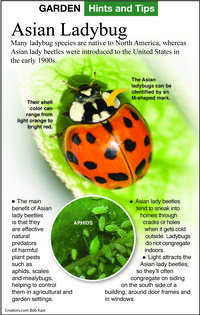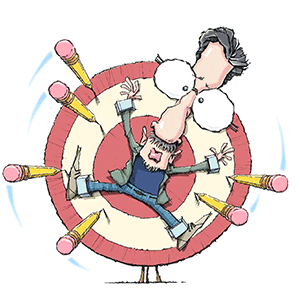The Greener View: Ladybug Invasion
Q: My house is being invaded by ladybugs. Why are they coming indoors when there is nothing in here for them? How do I get rid of them?
A: There are several thousand species of ladybugs, or lady beetles or ladybirds, as they may be called, depending on where you live and what your mom called them. Some are what horticulturists call beneficial insects. They eat aphids, mealybugs and mites that are eating our plants. Some ladybugs are pests because they also eat our plants. Most likely, the one trying to get into your house is the Asian ladybug.
In typical human fashion, it was decided years ago that if some beneficial ladybugs were good, then more would be better. As far back as 1916, many introductions of the Asian ladybug occurred in the U.S. and Europe. It wasn't until 1988 that they survived in New Orleans. They became established across most of the country within 10 years. They are doing too well. The native populations of ladybugs are declining to the point of extinction in areas where the Asian ladybugs are thriving.
They were introduced into the country because they ate aphids, but they quickly spread to eating more than 50 kinds of insects on many kinds of plants. They have saved farmers vast sums of money as they have protected soybeans, pecans and other crops. However, they can become a pest themselves when they run out of insects to eat and begin feeding on fruit. Every year I find them eating some of my raspberries, but they also eat holes into peaches, apples and other fruit.
Ladybugs spend the winter as adults. They get together in large groups and use their own body heat to stay warm. The ladybugs find each other using pheromone scents. The native ones tend to get together in piles of mulch or in hollow trees and logs.
In Asia, the Asian ladybugs overwinter in cracks in cliffs. Since there are more houses than cliffs in the U.S., they use houses as a substitute place to spend the winter. They find a crack under the siding or along a window frame. As more come, they leave more pheromone scent, and so even more come.
Sometimes the crack leads all the way into the house and they find their way indoors. Vacuuming them up is the easiest way to dispose of them. If they are on the house walls outside, you can spray them with an insecticidal soap to kill them. The one possible benefit to having this problem is that it identifies that your house has a leak that lets in outside air. Caulking the leaky spot stops the beetles and saves you money.
If desired, they can be let back outside while the weather is above freezing. If they come indoors over the winter or in the early spring (too early to be let outside) they can be kept in the refrigerator for several months. They need to be kept in a jar with air holes. Keep a damp paper towel crumpled up in the jar. This will keep them from drying out.
The Asian ladybugs can be orange, orange-red or black with a variety of different numbers of black spots on the back. People usually think the native beneficial ladybugs are bright stop sign red with black spots, but they also come in yellow, gray and black, and with or without spots. If the ladybugs have stripes, they are probably Colorado potato beetles, and since they are a pest, they should be killed. The adult and larvae of Colorado potato beetles are both voracious eaters of tomato, potato, eggplant and petunia plants. Green ladybugs are not ladybugs but are probably the adults of northern corn rootworm or cucumber beetles. Both are serious pests that should be killed.
Native ladybugs can be picked up by hand and will not bite or cause a stink. Asian ladybugs can secrete a yellow liquid that stains and stinks. Asian ladybugs do bite, and the bite is painful.
========
Email questions to Jeff Rugg at info@greenerview.com. To find out more about Jeff Rugg and read features by other Creators Syndicate writers and cartoonists, visit the Creators Syndicate website at www.creators.com.
Copyright 2025 Jeff Rugg. Distributed By Creators.








Comments